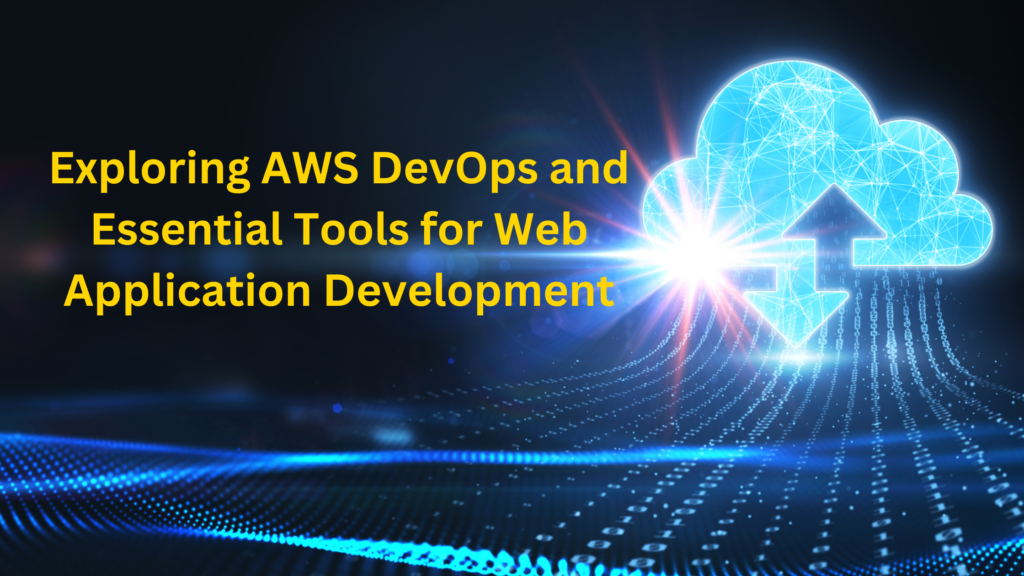AWS DevOps Unleashed: Must-Have Tools for Web Application Development

Introduction:
In the ever-evolving landscape of software development and IT operations, the synergy between DevOps practices and cloud computing platforms has revolutionized the way organizations deploy, manage, and scale their applications. This blog post aims to provide a comprehensive overview of DevOps, AWS (Amazon Web Services), and how they come together to form the powerful paradigm of AWS DevOps. We will explore the concept, architecture, essential tools, and best practices of AWS DevOps.
What is DevOps?
DevOps is a collaborative approach that brings together software development (Dev) and IT operations (Ops) to shorten the development lifecycle, increase the frequency of software releases, and improve the quality of software applications. DevOps emphasizes automation, continuous integration, continuous delivery (CI/CD), and a culture of collaboration among development, operations, and other stakeholders.
What is AWS (Amazon Web Services)?
Amazon Web Services (AWS) is a comprehensive cloud computing platform provided by Amazon. It offers a wide range of cloud services, including computing power, storage, databases, analytics, machine learning, networking, security, and more. AWS enables organizations to deploy applications and services quickly, scale as needed, and only pay for the resources they consume.
What is AWS?
AWS DevOps embodies Amazon’s response to embracing the DevOps philosophy through its cloud ecosystem and dedicated toolkit of services. Echoing their perspective, “AWS presents an array of adaptable services meticulously crafted to empower enterprises in swiftly and dependably constructing and delivering products using both AWS and DevOps methodologies. These services simplify the chore of provisioning and overseeing infrastructure, orchestrating application code deployment, automating software release lifecycles, and scrutinizing application and infrastructure performance.”
AWS DevOps equips teams of application developers with the means to proficiently institute continuous integration and continuous delivery (CI/CD). This facilitates the secure storage and versioning of application source code, with automated processes encompassing building, testing, and ultimate deployment of the application, whether within on-premises environments or onto the AWS cloud.
Within the realm of cloud computing, three principal categories take center stage:
- Software as a Service (SaaS)
- Platform as a Service (PaaS)
- Infrastructure as a Service (IaaS)
AWS finds its place within the IaaS category, representing a scalable, instantly accessible computing infrastructure entirely under the customer’s control. This encompasses virtual servers and operating systems (OSes).
Having gained an introductory understanding of AWS DevOps, let us advance our exploration by delving into the intricate architecture of AWS DevOps.
AWS DevOps Architecture Deconstructed
In order to gain a more comprehensive understanding of the implementation of DevOps within the AWS environment, it’s essential to dissect the foundational architecture. For illustrative purposes, we’ll take AWS EC2 (Elastic Compute Cloud) as our prime example. EC2 serves as the gateway to configuring virtual machines and the underlying resources they tap into, all managed from a central console. The integration of automation empowers IT administrators to dynamically scale resources to match the organization’s requirements, rendering the entire process remarkably pliable and cost-effective.
- Load Balancing: A fundamental aspect of most web application architectures, load balancing distributes EC2 traffic across an array of available web server resources. This allocation can be seamlessly adjusted based on fluctuations in traffic demand. The Elastic Load Balancing service provided by AWS automates this process.
- Amazon CloudFront: Designed to deliver content, such as websites, including dynamic, streaming, and static content types, CloudFront seamlessly operates in conjunction with other AWS components. Importantly, it’s also compatible with non-AWS cloud environments.
- Amazon Security Group: With security concerns paramount, this feature acts as an inbound network firewall. EC2 access is granted only to specified protocols, ports, and source IP ranges, each mapped to authorized traffic streams directed to appropriate EC2 instances.
- Elastic Caches: This web service effectively manages cloud memory caching, alleviating service strain by storing frequently accessed data. This optimization significantly bolsters performance and scalability.
- Amazon Relational Database Service (RDS): Simplifying the setup, operations, and scalability of cloud-based relational databases, RDS takes on routine database administration tasks. It offers an easily scalable and cost-effective solution for working with databases, supporting Amazon Aurora, MariaDB, Microsoft SQL Server, MySQL, Oracle, and PostgreSQL.
- Amazon Simple Storage Service (S3): Two pathways exist for accessing, backing up, and storing web application data and assets in the AWS cloud. S3 provides a user-friendly interface for data management, regardless of volume, accessible from anywhere on the web. Data is stored as objects within buckets, enabling manipulation as needed.
- Amazon Elastic Block Store (EBS): Geared toward high-performance block storage, EBS assists in data partitioning and application log management. It’s an optimal choice for swift access and long-term data persistence, particularly suitable for primary storage for databases, file systems, and applications requiring unformatted, raw, block-level storage with granular update capabilities.
- Amazon Auto Scaling: This service empowers the creation of capacity groups comprising servers, adjustable on-demand to accommodate fluctuations in resource requirements.
With a thorough exploration of the architectural components complete, the subsequent step is to delve into the diverse toolkit encompassing the realm of AWS DevOps
Conclusion
AWS DevOps represents a powerful synergy between DevOps principles and the capabilities of Amazon Web Services. By leveraging AWS services and tools, organizations can achieve faster development cycles, more frequent releases, and improved software quality. Understanding the architecture, tools, and best practices of AWS DevOps is essential for modern software development and operational success in the cloud era.

Leave a Reply